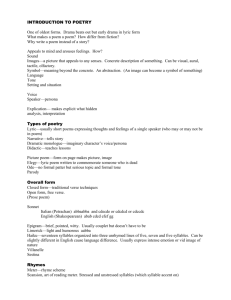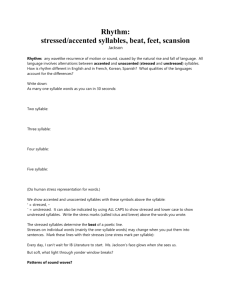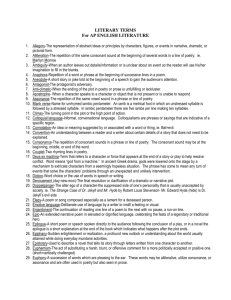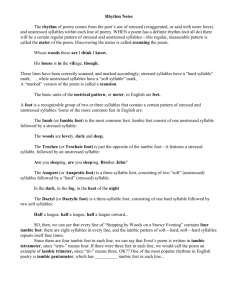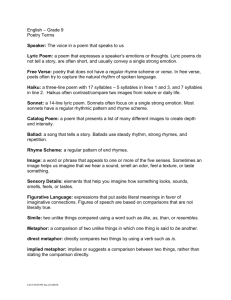Literary Terms
advertisement
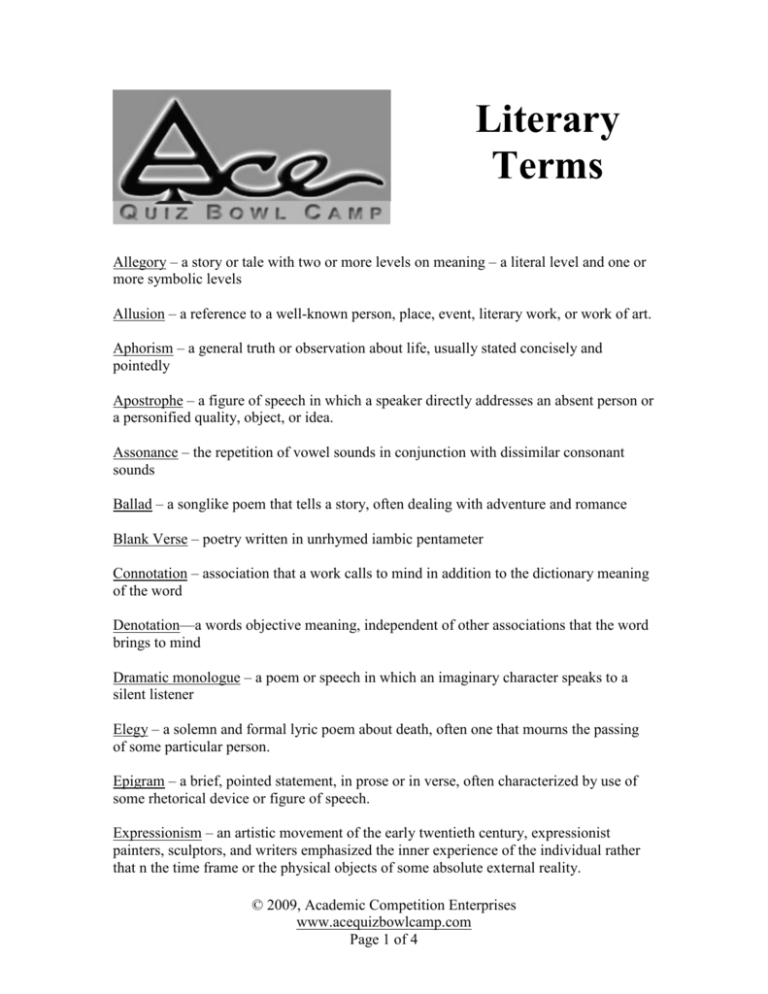
Literary Terms Allegory – a story or tale with two or more levels on meaning – a literal level and one or more symbolic levels Allusion – a reference to a well-known person, place, event, literary work, or work of art. Aphorism – a general truth or observation about life, usually stated concisely and pointedly Apostrophe – a figure of speech in which a speaker directly addresses an absent person or a personified quality, object, or idea. Assonance – the repetition of vowel sounds in conjunction with dissimilar consonant sounds Ballad – a songlike poem that tells a story, often dealing with adventure and romance Blank Verse – poetry written in unrhymed iambic pentameter Connotation – association that a work calls to mind in addition to the dictionary meaning of the word Denotation—a words objective meaning, independent of other associations that the word brings to mind Dramatic monologue – a poem or speech in which an imaginary character speaks to a silent listener Elegy – a solemn and formal lyric poem about death, often one that mourns the passing of some particular person. Epigram – a brief, pointed statement, in prose or in verse, often characterized by use of some rhetorical device or figure of speech. Expressionism – an artistic movement of the early twentieth century, expressionist painters, sculptors, and writers emphasized the inner experience of the individual rather that n the time frame or the physical objects of some absolute external reality. © 2009, Academic Competition Enterprises www.acequizbowlcamp.com Page 1 of 4 Fable – A brief story, usually with animal characters, that teaches a lesson, or moral Free Verse – poetry that lacks a regular rhythmical pattern or meter Hyperbole – a deliberate exaggeration or overstatement Iambic Pentameter – a line of poetry with five iambic feet, each containing one unstressed syllable followed by one stressed syllable, it may be rhymed or unrhymed. Idyll – a poem or part of a poem that describes and idealizes life. Irony – a contrast between what is stated and what is meant, or between what is expected to happen and what actually happens. Local Color – the use in literary work of characters and details unique to a particular geographic area Lyric Poem – a melodic poem that expresses the observations and feelings of a single speaker Metaphor – a figure of speech in which one thing is spoken of as though it were something else Meter – a poem’s rhythmical pattern. The pattern is determined by the number and types of stresses, or beats, in each line Iamb – a foot with one unstressed syllable followed by one stressed syllable, as in the word “around” Troche – a foot with one unstressed syllable followed by one unstressed syllable, and in the word “broken” Anapest – a foot with two unstressed syllables followed by one stressed syllable and in the phrase “in a flash” Dactyl – a foot with one stressed syllable followed by two unstressed syllables, and in the work “argument” Spondee – a foot with two stressed syllables, as in the word “airship” Pyrrhic – a foot with two unstressed syllables, as in the last foot on the word “imagining” Amphibrach – a foot with an unstressed syllable, one stressed syllable, and another stressed syllable, as in the word “ungainly” © 2009, Academic Competition Enterprises www.acequizbowlcamp.com Page 2 of 4 Amphimacer – a foot with a stressed syllable, one unstressed syllable, and another stressed syllable as in “give and take” Naturalism – was a literary movement among novelists at the end of the nineteenth century and the early decades on the twentieth century. They tended to view people as hapless victims of immutable natural laws Ode – a long, formal lyric poem with a serious theme that may have a traditional stanza structure Onomatopoeia – the use of words that imitate sounds Oxymoron – a figure of speech that combines two opposing or contradictory ideas Parable – a brief story, usually with human characters, that teaches a moral lesson Paradox – a statement that seems to be contradictory, but that actually presents the truth Parody – a humorous interpretation of a literary work. It exaggerates or distorts the characteristic features of the original Personification – a figure of speech in which a nonhuman subject is given human characteristics Realism – the presentation in are of the detail of actual life. Realism was also a literary movement that began during the nineteenth century and that stressed the actual as opposed to the imagined or the fanciful. Refrain – a repeated line or group of lines in a poem or song Regionalism – the tendency among certain authors to write about specific geographical areas Romanticism – literary and artistic movement of the 19th century, on that arose in reaction against 18th century neoclassicism and that placed a premium on fancy, imagination, individuality, and exotica Satire – writing that ridicules or criticizes individuals, ideas, institutions, social conventions, or other works of literature. Simile – a figure of speech that makes a direct comparison between two subjects using like or as Soliloquy – in a play or prose work is a long speech made by a character who is alone and who reveals his or her private thoughts and feelings to the audience © 2009, Academic Competition Enterprises www.acequizbowlcamp.com Page 3 of 4 Sonnet – a 14 line lyric poem focused on a single theme Stanza – a group of lines in a poem, considered as a unit Stream of Consciousness – a narrative technique that presents thoughts as if they were coming directly from a character’s mind Synecdoche – a figure of speech in which a part of something is used to stand for the whole thing Transcendentalism – an American literary and philosophical movement of the 19th century. The transcendentalists, who were based in New England, believed that intuition and the individual conscience “transcend” the experience and thus are better guides to truth than are the senses and logical reason Vernacular – the ordinary language of people in a particular region Villanelle – a 19 line poem with only two rhymes that follows a strict pattern popular in traditional French poetry. © 2009, Academic Competition Enterprises www.acequizbowlcamp.com Page 4 of 4
